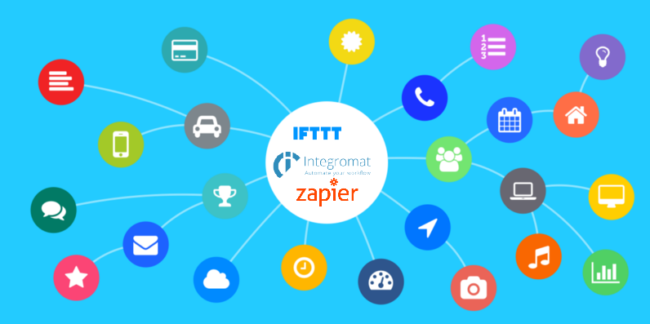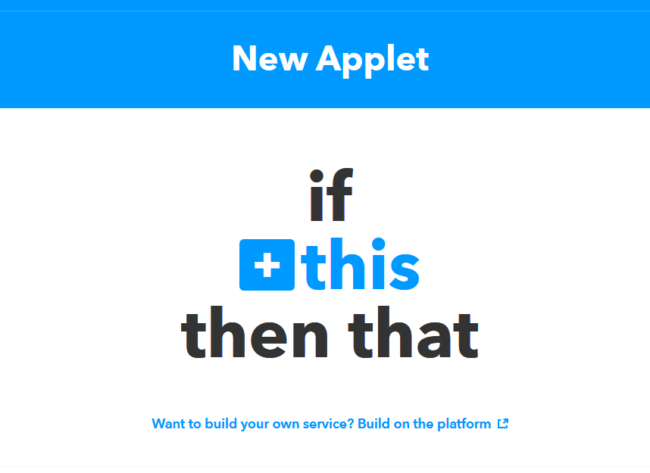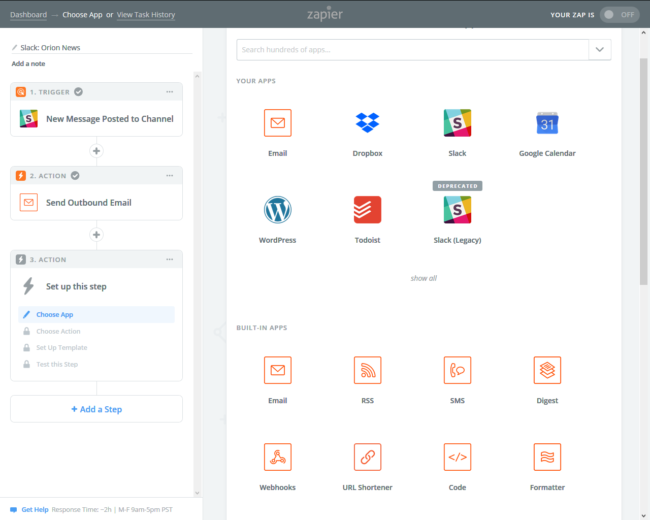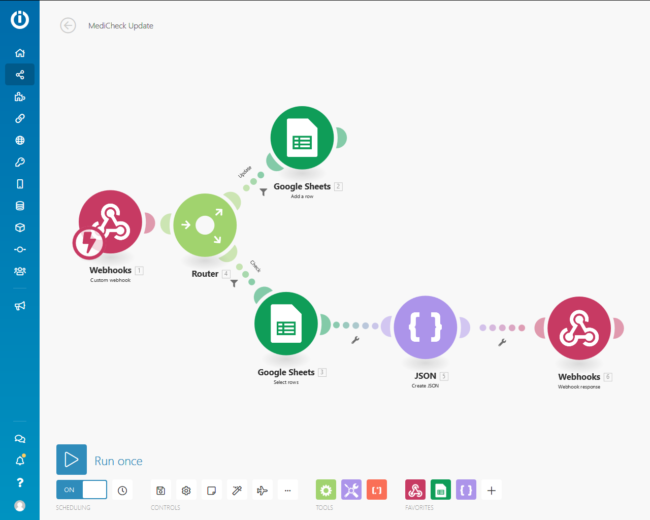 A web integration tool can be used to link two totally different systems. An easy example would be “Whenever I tweet, post it to Facebook”, or “Whenever someone posts to this page, send me an email”. But it can get a lot more sophisticated – I currently have automations set up that watch for specific YouTube videos and copy them to my Plex account, so they appear automatically on my home TV system; I have recently come up with a system that lets me log my medications via Alexa, and record them in Google Sheets.
A web integration tool can be used to link two totally different systems. An easy example would be “Whenever I tweet, post it to Facebook”, or “Whenever someone posts to this page, send me an email”. But it can get a lot more sophisticated – I currently have automations set up that watch for specific YouTube videos and copy them to my Plex account, so they appear automatically on my home TV system; I have recently come up with a system that lets me log my medications via Alexa, and record them in Google Sheets.
IFTTT has definitely been around the longest, Zapier and Integromat are somewhat more sophisticated. But they are all useful in their way.
Cost
One factor has got to be cost. In this respect, IFTTT wins hand-down, as it is a free tool.
Zapier has 5 different plans, ranging through Free, $25, $50, $75, $125. The Free option allow you just 5 zaps, and only 100 tasks/month. This means it only allows you 5 different integrations, and they can only work a total of 100 times per month. Which is plenty for experimenting with, or even for a daily task, but you are not really going to achieve that much on the free plan.
Integromat also has a range of plans – Free, $9, $29, $99, $299 – but here the Free option is a lot more useful – as many integrations as you like, limited to 1000 operations a month and 100Mb data transfer.
Now that 1000 operations looks stellar, compared to Zapier’s 100. But they are calculated differently. Integromat counts each stage of an integration as an operation. Hence if you are picking up an item at source, and then passing it through to another system, then that is 2 operations each time it runs. If, however, you are parsing the data, and sending it in different directions, it is an operation for picking up the data, one for parsing it, and one for each of the destinations. As a result, it is easier than you might think to work through 1,000 operations in a month, particularly if you are repeatedly triggering something while testing/developing. However, I find it is fairly adequate for reasonable use, and the cost of going to the next plan is not much – just $9 gets you 10,000 Operations and 1 Gb Data.
Note: I have never used my my 100Mb/month data allocation – the amounts of data involved aren’t that big.
The other thing that Integromat limits is the frequency it checks for things when using scheduled events. For the Free account, the minimum interval between activations is 15 minutes, for the $9 account it is 5 minutes (the more expensive accounts reduce this to 1 minute). But again, I find this perfectly adequate for what I am doing.
Connections
Another thing to consider is connections – what systems do these tools connect to? They can all connect to the more common services, but there are significant differences in coverage. So this is the first thing to check; whether your tool of choice actually supports the services you want to work with.
Roughly speaking, IFTTT supports about 400 different services, whereas Zapier claims 1200+. Integromat says it connects to “hundreds”. However, it should be noted that in reality, the numbers are lower, with many services being represented by multiple separate connections – i.e. Facebook, Facebook Pages, Facebook Groups etc. Zapier’s numbers also includes a wide range of bespoke “internet ready” devices – kitchen equipment and such – and services I have never even heard of.
In real terms, I have found Integromat to be the most useful, although it has surprising gaps. For example, I recently found that Integromat does not connect to Hive (BT Heating and Light system), whereas the more basic IFTTT does.
All three services support webhooks in one form or another, enabling you to configure for systems not directly supported. In this respect, Integromat is a clear leader, as not only can it receive HTTP(S) GET Queries and POST JSON, but can send back custom header responses and JSON content. One might ask that if you are going to use JSON, why you don’t integrate directly with your own code, but these tools make it easier.
Complexity
The three tools have different levels of complexity. As the name suggests, IFTTT (If That Then This) has only two stages – “That” and “This”. It couldn’t be any easier.

Zapier can have multiple stages, but it is still a sequential process; first a trigger, then one or more actions.

Integromat is much more complex, with forking structures and logic, including filters and if/then structures. Even so, the GUI makes it pretty easy to follow and develop.

The above project allows for a connection via the Webhooks interface that either enquires after information from Google Sheets (the lower path) or updates Google Sheets with new information (the upper path. This is being used to integrate the data being held in my spreadsheet with Alexa via voice activation, working in real-time.
In Conclusion
So which is best? Lately, I have been playing with Integromat a lot. It is a pleasure to use, and fairly simple to pick up, At the same time, I still have a number of automations on IFTTT, that are simple and work well. I currently have no automations on Zapier, but that doesn’t mean I don’t think it a good tool; merely that I think their usage plans a little restrictive/expensive.
The Not So Good News
One would hope one could set these automations up and that would be it; at least, that is normally the plan. Alas, it doesn’t always work out that way. Most of the integrations these tools use rely on published APIs from the services involved. As mentioned above, you could even write your own integration code; services like IFTTT, Zapier and Integromat just make things easier.
But when services change or withdraw their API, things fall apart. A good example of this is Facebook, who dropped their API following the Cambridge Analytica scandal. Overnight, automations using these APIs simply stopped. More recently Facebook even halted their own “posting via email” service for Facebook groups- it is still documented, but no longer works.
Any change to API will affect the likes of IFTTT, Zapier and Integromat – they will need to rewrite their integration based on the new version of the API. Normally one would wish for a bit of notice of any change. In the case of Facebook, no notice was given and things stopped. This is frustrating for both users and the owners of these integration services. Currently they are all waiting for new integrations to be approved by Facebook.

Be First to Comment